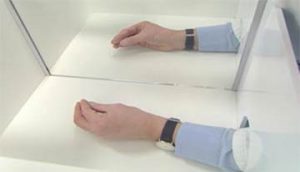Mirror Therapy for CRPS/RSD
 Mirror therapy is one of the many treatments that is used for CRPS/RSD. At present there is no CRPS cure so interventions work on reducing symptoms and allowing you to manage your pain. It has been suggested there are between 150-200 different treatment used for CRPS. The RCP Guidelines provide a list of recommend treatments for CRPS which have been tested and proven to be effective. They recommend CRPS treatment with mirror box therapy.
Mirror therapy is one of the many treatments that is used for CRPS/RSD. At present there is no CRPS cure so interventions work on reducing symptoms and allowing you to manage your pain. It has been suggested there are between 150-200 different treatment used for CRPS. The RCP Guidelines provide a list of recommend treatments for CRPS which have been tested and proven to be effective. They recommend CRPS treatment with mirror box therapy.
Many studies have found mirror therapy to benefit patients with CRPS. One was a study by McCabe et al. (2003). He studied eight subjects and found that, patients with recent onset of CRPS showed significant benefit from mirror therapy for reduction of pain, patients in the intermediate stage showed reduction in stiffness.
It is thought that pain in CRPS is caused by a mismatch between proprioceptive feedback and motor action. Visual feedback is prioritised over proprioceptive, so it can be made to match the motor action and therefore reduce pain. A mirror can be used to provide this visual feedback in the form of mirror box therapy. For example, in CRPS hand therapy, the affected hand is placed behind the mirror. The non-affected hand is then moved and the image is viewed as the affected hand moving. The brain is now receiving visual feedback that the hand is moving normally without pain which corrects the mismatch that has been occurring.
Another theory as to why mirror box therapy is effective in treating CRPS is cortical reorganisation. In CRPS the affected limb is not used, or is used less, due to pain. This lack of use leads to altered or absent sensory feedback from the limb and results in cortical reorganisation of body’s representation in the brain. The amount of reorganisation has been shown to correlated with the severity of pain. This reorganization may be changed by providing alternative sensory input using a visual illusion, thereby reducing pain.
For example, in CRPS leg therapy, the affected leg might be being used less due to pain. This may involve limping or using a walking aid to decrease weight on the foot. Over time, this lack of use leads to a smaller area of the brain representing that foot. This reorganisation can be the cause of pain. Using mirror therapy to increase the observed movement of that foot without pain will increase the foots' representation in the brain again.
Despite which physiological method you choose to believe, the main benefit of mirror box therapy is that it is cheap, portable and easy to do on your own. Yes, studies show it may not work for everyone but no treatment is a “one size fits all”. It is worth attempting even if it can provide some small relief from the horrendous pain of CRPS.
To purchase the Mirror Therapy Rehab Kit For CRPS, Click Here.